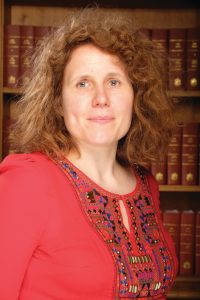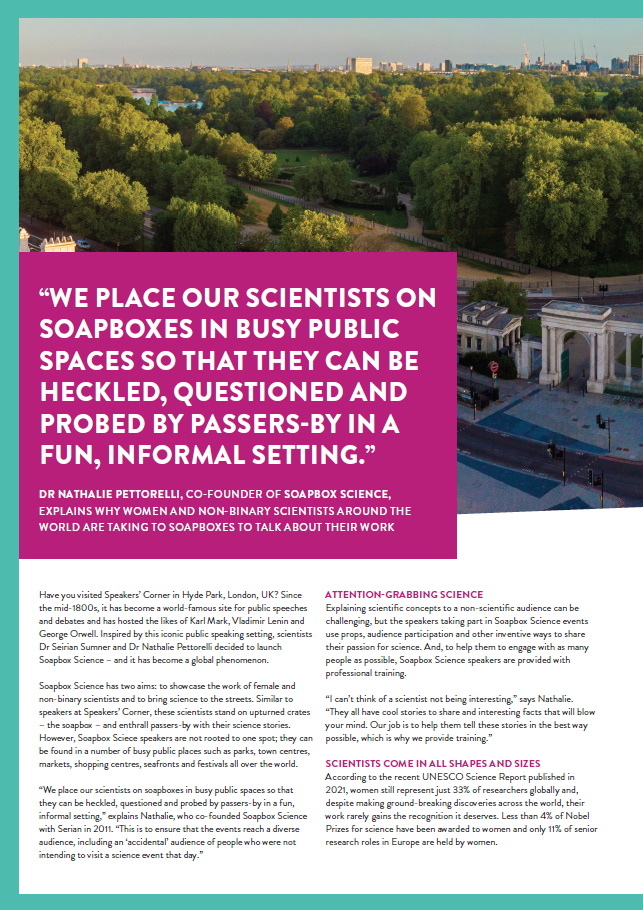“We place our scientists on soapboxes in busy public spaces.”
Dr Nathalie Pettorelli, co-founder of Soapbox Science, explains why women and non-binary scientists around the world are taking to soapboxes to talk about their work
Have you visited Speakers’ Corner in Hyde Park, London, UK? Since the mid-1800s, it has become a world-famous site for public speeches and debates and has hosted the likes of Karl Mark, Vladimir Lenin and George Orwell. Inspired by this iconic public speaking setting, scientists Dr Seirian Sumner and Dr Nathalie Pettorelli decided to launch Soapbox Science – and it has become a global phenomenon.
Soapbox Science has two aims: to showcase the work of female and non-binary scientists and to bring science to the streets. Similar to speakers at Speakers’ Corner, these scientists stand on upturned crates – the soapbox – and enthrall passers-by with their science stories. However, Soapbox Science speakers are not rooted to one spot; they can be found in a number of busy public places such as parks, town centres, markets, shopping centres, seafronts and festivals all over the world.
“We place our scientists on soapboxes in busy public spaces so that they can be heckled, questioned and probed by passers-by in a fun, informal setting,” explains Nathalie, who co-founded Soapbox Science with Serian in 2011. “This is to ensure that the events reach a diverse audience, including an ‘accidental’ audience of people who were not intending to visit a science event that day.”
ATTENTION-GRABBING SCIENCE
Explaining scientific concepts to a non-scientific audience can be challenging, but the speakers taking part in Soapbox Science events use props, audience participation and other inventive ways to share their passion for science. And, to help them to engage with as many people as possible, Soapbox Science speakers are provided with professional training.
“I can’t think of a scientist not being interesting,” says Nathalie. “They all have cool stories to share and interesting facts that will blow your mind. Our job is to help them tell these stories in the best way possible, which is why we provide training.”
SCIENTISTS COME IN ALL SHAPES AND SIZES
According to the recent UNESCO Science Report published in 2021, women still represent just 33% of researchers globally and, despite making ground-breaking discoveries across the world, their work rarely gains the recognition it deserves. Less than 4% of Nobel Prizes for science have been awarded to women and only 11% of senior research roles in Europe are held by women.
Nathalie and Seirian were both ‘For Women in Science’ fellows when they decided to launch Soapbox Science. ‘For Women in Science’ is a prestigious award, which supports around 250 talented young women researchers a year and is led by The Fondation L’Oréal and UNESCO. “We decided to set up Soapbox Science following a series of personal experiences and realisations,” says Nathalie. “Firstly, there are fewer and fewer female role models available in science as you progress up the career ladder; secondly, sexism in science is alive and kicking, if you allow yourself to notice it; in addition, science stories are mostly told by males; lastly, celebrated science heroes are mostly male.”
As Seirian and Nathalie progressed in their science careers, it became increasingly apparent to them that something needed to be done, and, in 2011, L’Oréal gave them the funding they needed to get started. “When we created Soapbox Science, we wanted to demonstrate that there was a need, and a niche, for public outreach platforms that challenge stereotypes about what sort of person a scientist is and what it means to be a scientist,” says Nathalie. “At each event, we try to optimise the diversity of speakers, with respect to discipline, career stage and background. Our goal is to show that scientists come in all kinds of shapes and sizes.”
PUTTING FEMALE AND NON-BINARY SCIENTISTS IN THE LIMELIGHT
In a joint blog post written for The Guardian in 2014, Seirian and Nathalie wrote, “Female scientists are less likely to be in the media; less likely to be listed as either first or last author on a scientific paper; less likely to be invited to review and comment on papers published by prestigious journals; and less likely to speak at scientific conferences.”
Have you visited Speakers’ Corner in Hyde Park, London, UK? Since the mid-1800s, it has become a world-famous site for public speeches and debates and has hosted the likes of Karl Mark, Vladimir Lenin and George Orwell. Inspired by this iconic public speaking setting, scientists Dr Seirian Sumner and Dr Nathalie Pettorelli decided to launch Soapbox Science – and it has become a global phenomenon.
Soapbox Science has two aims: to showcase the work of female and non-binary scientists and to bring science to the streets. Similar to speakers at Speakers’ Corner, these scientists stand on upturned crates – the soapbox – and enthrall passers-by with their science stories. However, Soapbox Science speakers are not rooted to one spot; they can be found in a number of busy public places such as parks, town centres, markets, shopping centres, seafronts and festivals all over the world.
“We place our scientists on soapboxes in busy public spaces so that they can be heckled, questioned and probed by passers-by in a fun, informal setting,” explains Nathalie, who co-founded Soapbox Science with Serian in 2011. “This is to ensure that the events reach a diverse audience, including an ‘accidental’ audience of people who were not intending to visit a science event that day.”
ATTENTION-GRABBING SCIENCE
Explaining scientific concepts to a non-scientific audience can be challenging, but the speakers taking part in Soapbox Science events use props, audience participation and other inventive ways to share their passion for science. And, to help them to engage with as many people as possible, Soapbox Science speakers are provided with professional training.
“I can’t think of a scientist not being interesting,” says Nathalie. “They all have cool stories to share and interesting facts that will blow your mind. Our job is to help them tell these stories in the best way possible, which is why we provide training.”
SCIENTISTS COME IN ALL SHAPES AND SIZES
According to the recent UNESCO Science Report published in 2021, women still represent just 33% of researchers globally and, despite making ground-breaking discoveries across the world, their work rarely gains the recognition it deserves. Less than 4% of Nobel Prizes for science have been awarded to women and only 11% of senior research roles in Europe are held by women.
Nathalie and Seirian were both ‘For Women in Science’ fellows when they decided to launch Soapbox Science. ‘For Women in Science’ is a prestigious award, which supports around 250 talented young women researchers a year and is led by The Fondation L’Oréal and UNESCO. “We decided to set up Soapbox Science following a series of personal experiences and realisations,” says Nathalie. “Firstly, there are fewer and fewer female role models available in science as you progress up the career ladder; secondly, sexism in science is alive and kicking, if you allow yourself to notice it; in addition, science stories are mostly told by males; lastly, celebrated science heroes are mostly male.”
As Seirian and Nathalie progressed in their science careers, it became increasingly apparent to them that something needed to be done, and, in 2011, L’Oréal gave them the funding they needed to get started. “When we created Soapbox Science, we wanted to demonstrate that there was a need, and a niche, for public outreach platforms that challenge stereotypes about what sort of person a scientist is and what it means to be a scientist,” says Nathalie. “At each event, we try to optimise the diversity of speakers, with respect to discipline, career stage and background. Our goal is to show that scientists come in all kinds of shapes and sizes.”
PUTTING FEMALE AND NON-BINARY SCIENTISTS IN THE LIMELIGHT
In a joint blog post written for The Guardian in 2014, Seirian and Nathalie wrote, “Female scientists are less likely to be in the media; less likely to be listed as either first or last author on a scientific paper; less likely to be invited to review and comment on papers published by prestigious journals; and less likely to speak at scientific conferences.”
Eight years later, much of this still holds true. Nathalie believes that although progress has been made since the publication of this blog post, we are far from parity: “For example, a number of articles have highlighted that COVID-19 press briefings in the UK have primarily been led by men. Moreover, a recent analysis of biomedical awards over five decades, published in Nature, showed that men receive more cash and respect for their research than women do.”
While these statements make for sober reading, there is a lot to be optimistic about. There are hundreds of organisations all over the world, like Soapbox Science, that are making it their mission to promote and support equality and diversity in STEMM (science, technology, engineering, maths and medicine). There are scientists from all manner of backgrounds, and of various ethnicities and genders, who are paving the way for even more scientists with similar or novel backgrounds and experiences. And there are individuals, like Nathalie and Seirian, who are championing free speech so that we can all feel connected with each other and valued for who we are. What would inspire you to get on a soapbox?
MEET NATHALIE

Senior Research Fellow at the Institute of Zoology, UK Co-Founder, Soapbox Science
WHAT WAS YOUR MOTIVATION FOR STUDYING SCIENCE WHEN YOU WERE YOUNGER?
I was interested in a huge range of things and had no idea what job I wanted to do! I decided to study science because this was, at the time, a choice that was the least likely to mean that I was committed to a specialised career path. During my first year at university, I met a PhD student; being from a working-class background and the first in my family to go to university, I had no idea about research careers and what it entailed. That chat opened my horizons and made me realise that I could develop a career in science that built on all my interests.
WHAT DO YOU LOVE MOST ABOUT THE WORK YOU DO?
There are many things I love about the work I do: I love being responsible for choosing what I do and how I do it; I love the diversity of activities: from research to communication, management and teaching. I never get bored with my job, which is why I can’t imagine doing anything else.
HAVE YOU STOOD ON A ‘SOAPBOX’?
I have made a lot of women and non-binary scientists stand on a soapbox, but I have never stood there myself. I co-created Soapbox Science to promote others’ work and not mine. That spot on that box isn’t for me, but I’m there to make sure there is a box, every year, in as many places as possible around the world.
WHY SHOULD STUDENTS CONSIDER A CAREER IN STEMM?
I don’t think the school curriculum does a great job at explaining what a career in STEMM looks like, or who it is likely to appeal to. As a kid, I wasn’t obsessed with maths and science; I found STEMM fields as interesting as philosophy, arts, geography or history, yet I ended up choosing a career in STEMM, precisely because it gave me the opportunity to combine all these interests.
To find out about events, visit the Soapbox Science website: soapboxscience.org
Follow the team on social media:
![]() youtube.com/channel/UCz3oBLNmVKD-pJUmjr0feKA
youtube.com/channel/UCz3oBLNmVKD-pJUmjr0feKA
Send an email: [email protected]






